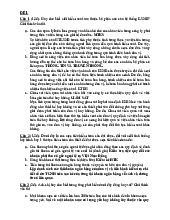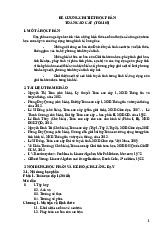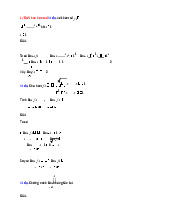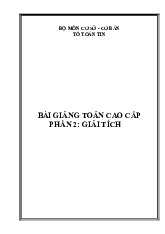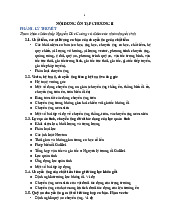






Preview text:
lOMoAR cPSD| 46578282 7/29/2020 METHODS OF ECONOMIC ANALYSIS Course Code: B03013 7/29/2020
B03013 – Chapter 0: Introduction 1 ACKNOWLEDGEMENT
• The contents of this slide are the supplemental
teaching material of the book Mike Rosser, [2003],
Basic mathematics for Economists, 2nd ed, Routledge, London.
• The purpose of this teaching material is to serve for
the subject “METHODS OF ECONOMIC
ANALYSIS” at Faculty of Banking and Finance, Ton Duc Thang University. 7/29/2020
B03013 – Chapter 0: Introduction 2 POLICIES FOR STUDENTS 1 lOMoAR cPSD| 46578282 7/29/2020
• These contents are only used for students PERSONALLY.
• Students are NOT allowed to modify or deliver
these contents to anywhere or anyone for any purpose. 7/29/2020
B03013 – Chapter 0: Introduction 3 COURSE INTRODUCTION Course Name
METHODS OF ECONOMIC ANALYSIS Course Code B03013 No. of credits 3 (2.1) Theory 30 teaching hours Time allocation Practice 30 teaching hours Self-study 90 hours 7/29/2020
B03013 – Chapter 0: Introduction 4 REQUIREMENTS 2 lOMoAR cPSD| 46578282 7/29/2020 METHODS OF None ECONOMIC ANALYSIS 7/29/2020
B03013 – Chapter 0: Introduction 5
COURSE LEARNING OUTCOME No. CLOs
1 Student will be able to explain the main concepts about
economic model and financial model;
2 Students could implement the basic research of financial economy;
3 Students have skills to calculate the statistic figure through mathematic economic model;
4 Students perceive the role and purpose of science, knowledge
through their studying and researching activities. 7/29/2020
B03013 – Chapter 0: Introduction 6 COURSE CONTENT (1) 3 lOMoAR cPSD| 46578282 7/29/2020 Chapter 1
One – Variable Calculus: Applications Chapter 2 Exponents and Logarithms Chapter 3 Examples of Linear Models Chapter 4
Unconstrained Optimization: Economics Application Chapter 5 Partial Differentiation 7/29/2020
B03013 – Chapter 0: Introduction 7 COURSE CONTENT (2) Chapter 6 Constrained Optimization Chapter 7 Further Topic in Calculus Chapter 8
Dynamics and Difference Equations Chapter 9 Matrix Algebra
Chapter 10 Asset/ Liability Cash Flow Matching 7/29/2020
B03013 – Chapter 0: Introduction 8 4 lOMoAR cPSD| 46578282 7/29/2020 TEACHING MATERIALS (1) Textbook
• [1] Mike Rosser, [2003], Basic mathematics for Economists, 2nd ed, Routledge, London.
Supplementary Readings
• [2] Carl P. Simon, Lawrence Blume, [1994], Mathematics for
Economists, Norton & Company, Inc. New York.
[3] Martin Anthony and Norman Biggs, [1996], Mathematics
for economics and finance: Methods and Modeling,
Cambridge University Press, Cambridge. 7/29/2020
B03013 – Chapter 0: Introduction 9 TEACHING MATERIALS (2) Additional Readings
• [4] Gerard Cornuejols, Reha T., [2007], Optimization Methods
in Finance, Cambridge University Press, Cambridge. [5] Huỳnh
Đạt Hùng, Nguyễn Khánh Bình, Phạm Xuân Giang [2011], Kinh
tế lượng. Nhà xuất bản Phương Đông, Cà Mau. 7/29/2020
B03013 – Chapter 0: Introduction 10 ASSESSMENT SCHEME 5 lOMoAR cPSD| 46578282 7/29/2020 Evaluation Weight Type of questions Category (%) In- class test 1 10 Process Exercise In- class test 2 20 Process Exercise Mid-term Test 20 Constructed response test Final exam 50 Report (Group) 7/29/2020
B03013 – Chapter 0: Introduction 11 STUDENT’S TASKS (1)
• Being on-time when class starts
• Staying until the end of class. Should students have to leave class early,
please have the courtesy of letting the instructor know before the
beginning of the period and leave quietly so as not to disturb the other members of the class.
• Being constructive to the learning environment. E-mail and the Internet
access are not allowed during lectures. Mobile phones (both smart and
inept) and other electronic devices need to be set to silent during class at all times.
• Being “present” in the class and focused on the class material. The
lectures will sometimes cover extra material (e.g., exercises,
discussions) which is not contained in lecture notes. Students are
responsible for everything covered or assigned in class. If students miss
a class, it is entirely their responsibility to determine what they have
missed including any administrative announcements lecturer may have made. 7/29/2020
B03013 – Chapter 0: Introduction 12 6 lOMoAR cPSD| 46578282 7/29/2020 STUDENT’S TASKS (2)
• Collect documents for their own research and expand the students’ knowledge.
• Coming prepared to contribute to the class.
• Communication with the lecturer.
• Students have to attend at least 80% of course requirement
(if this regulation is not fulfilled, students are not eligible to take their final exam). 7/29/2020
B03013 – Chapter 0: Introduction 13 7
